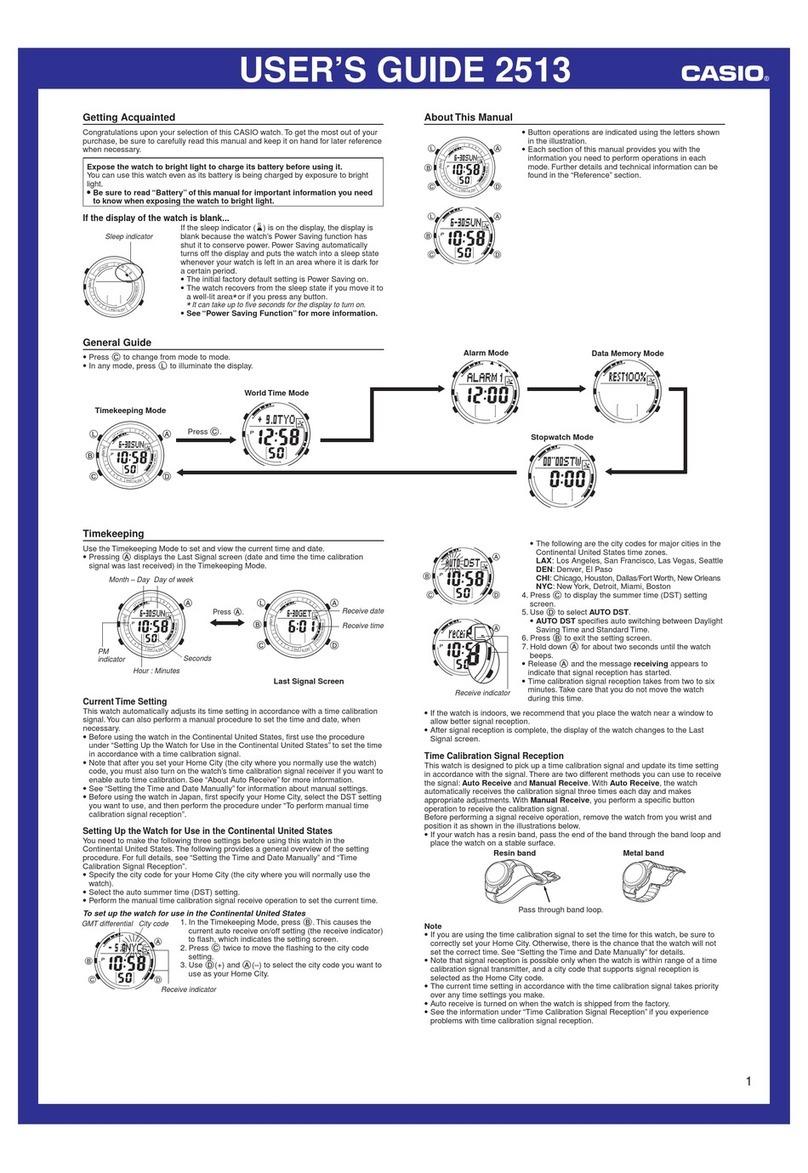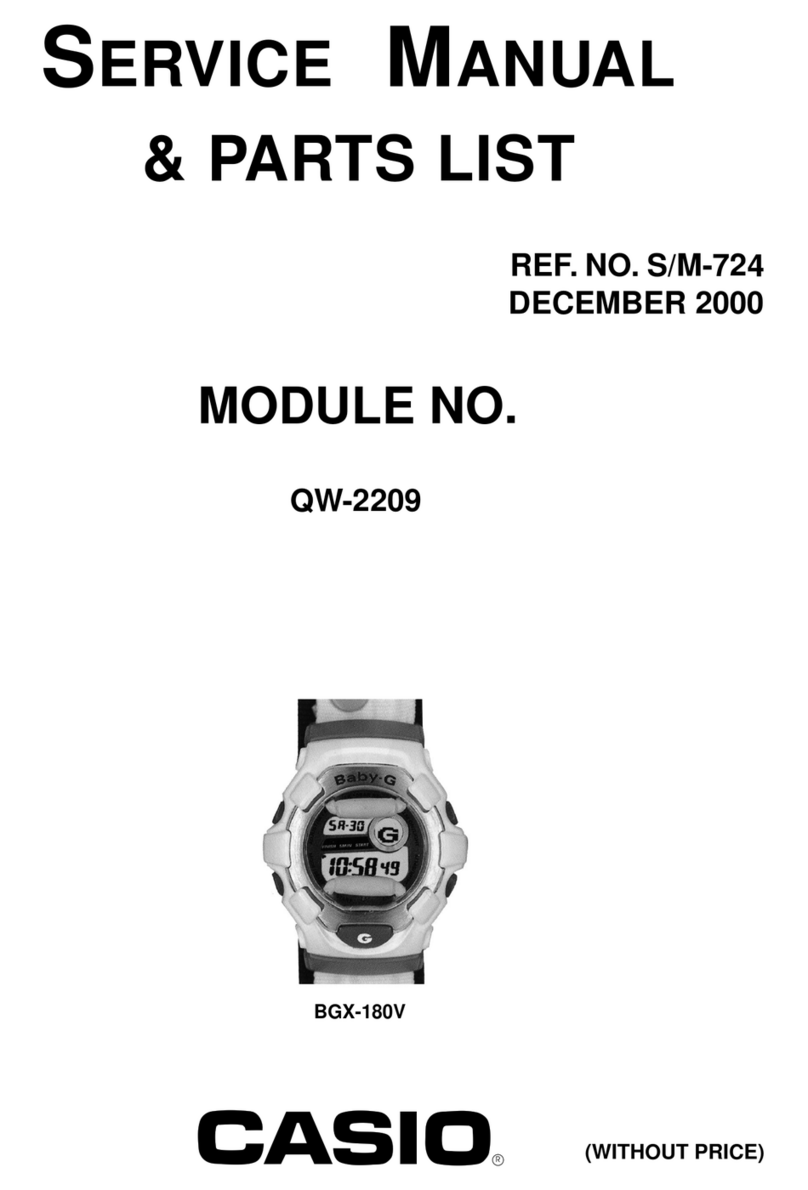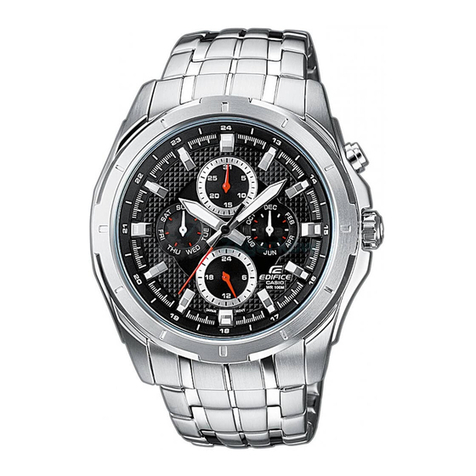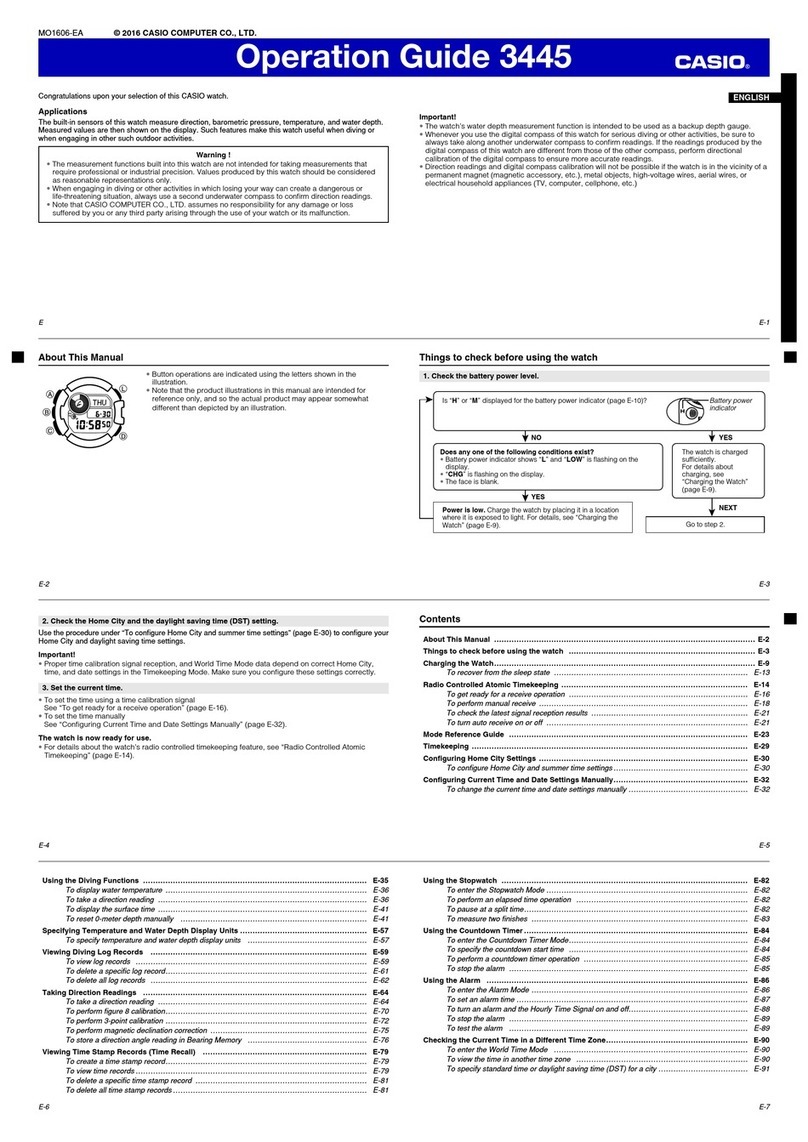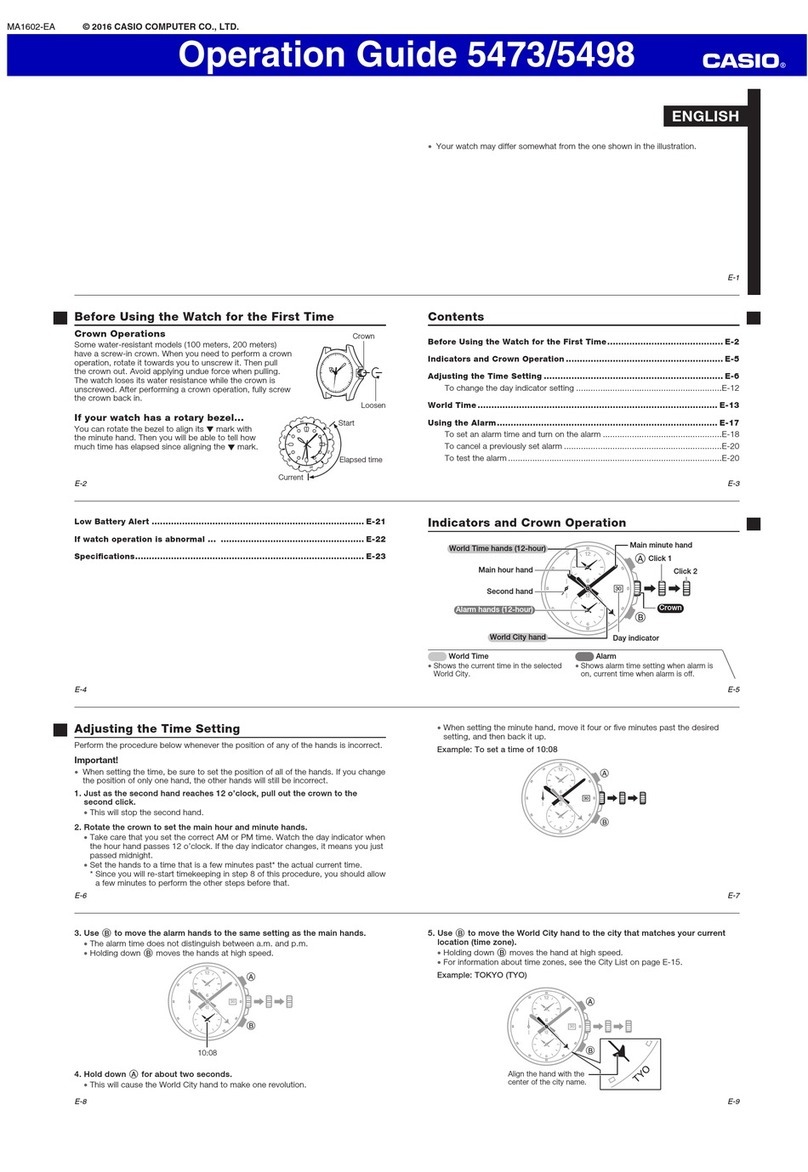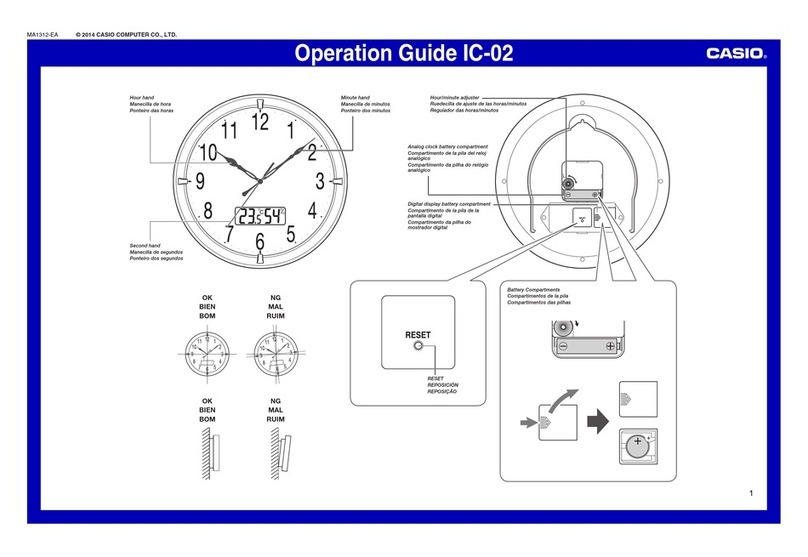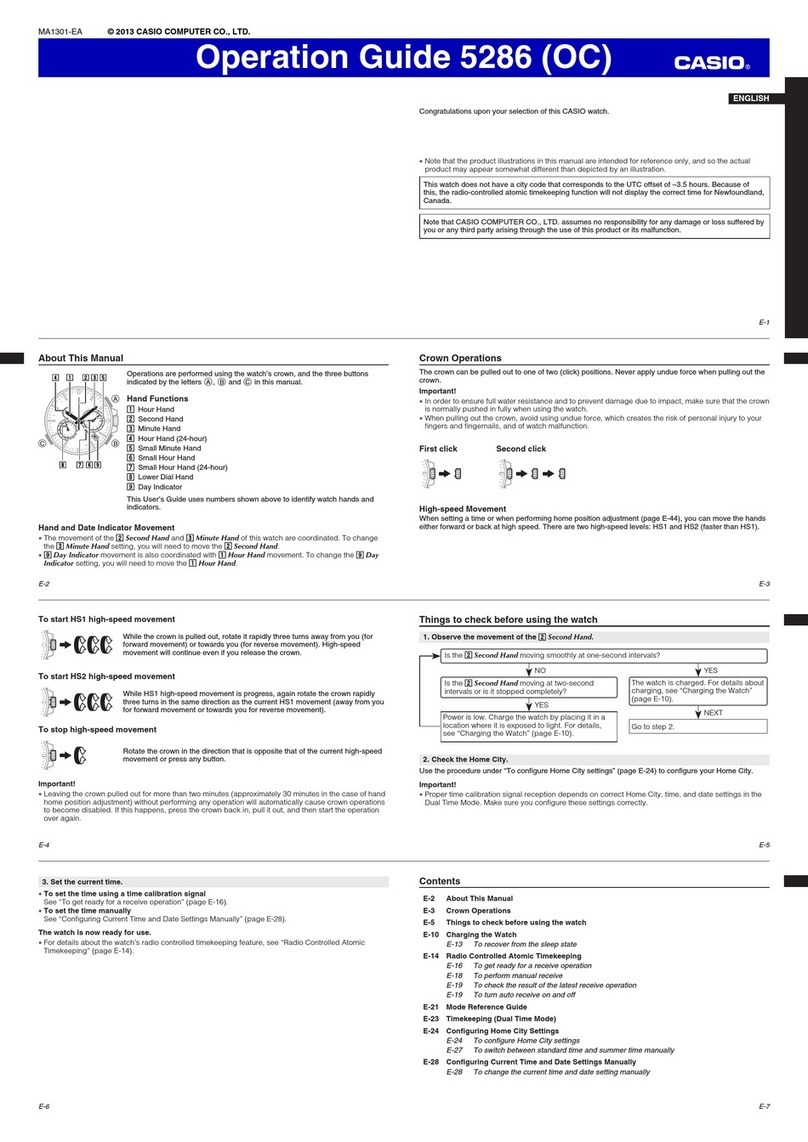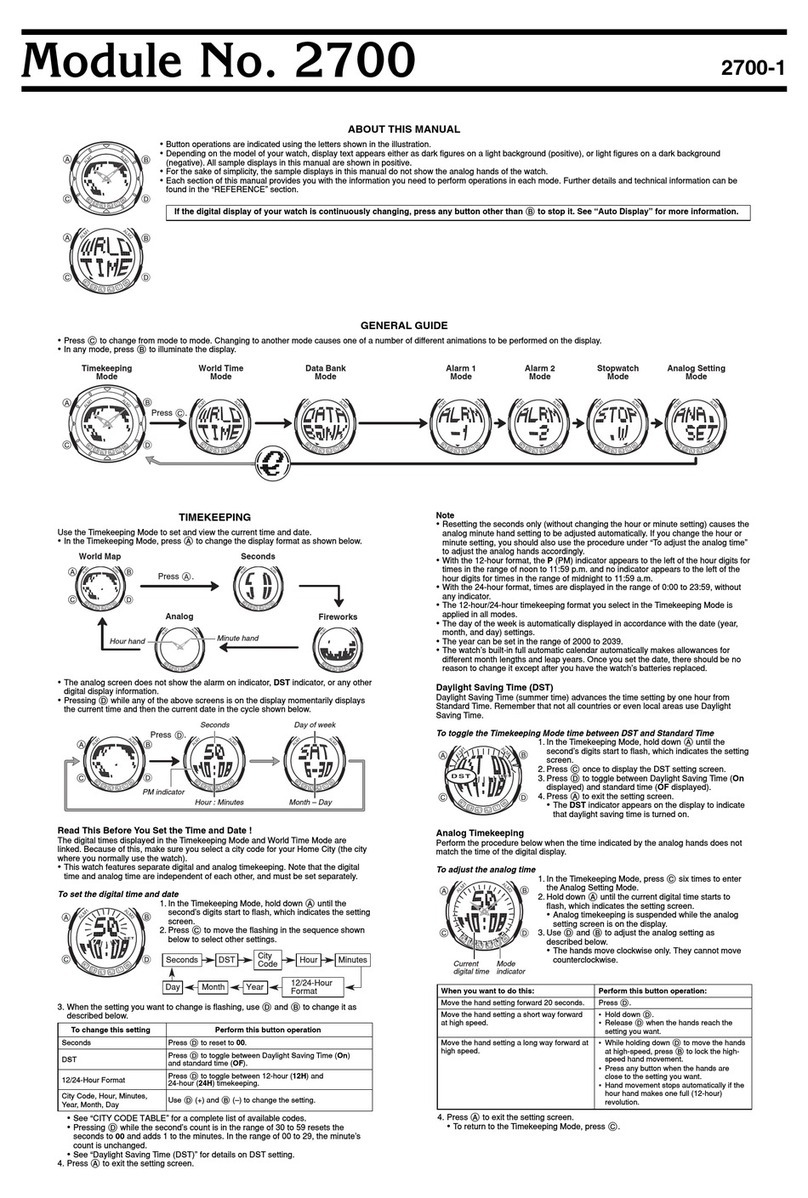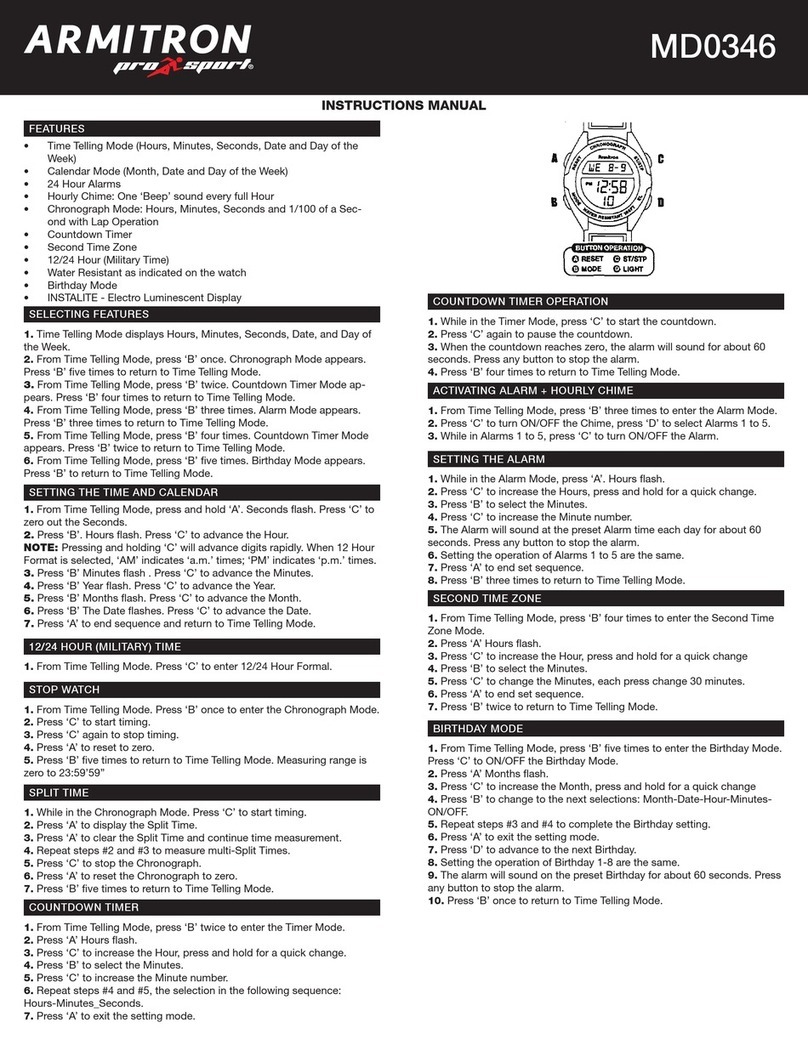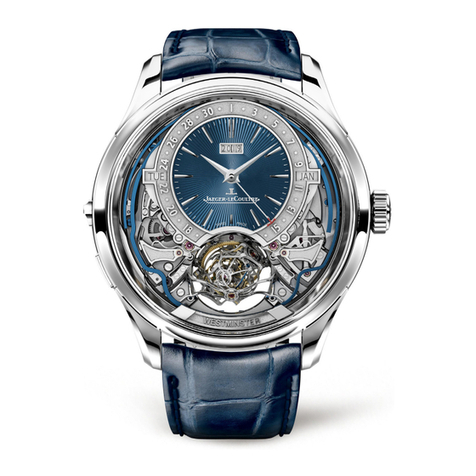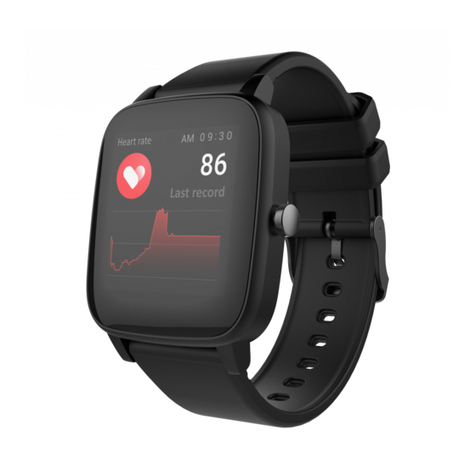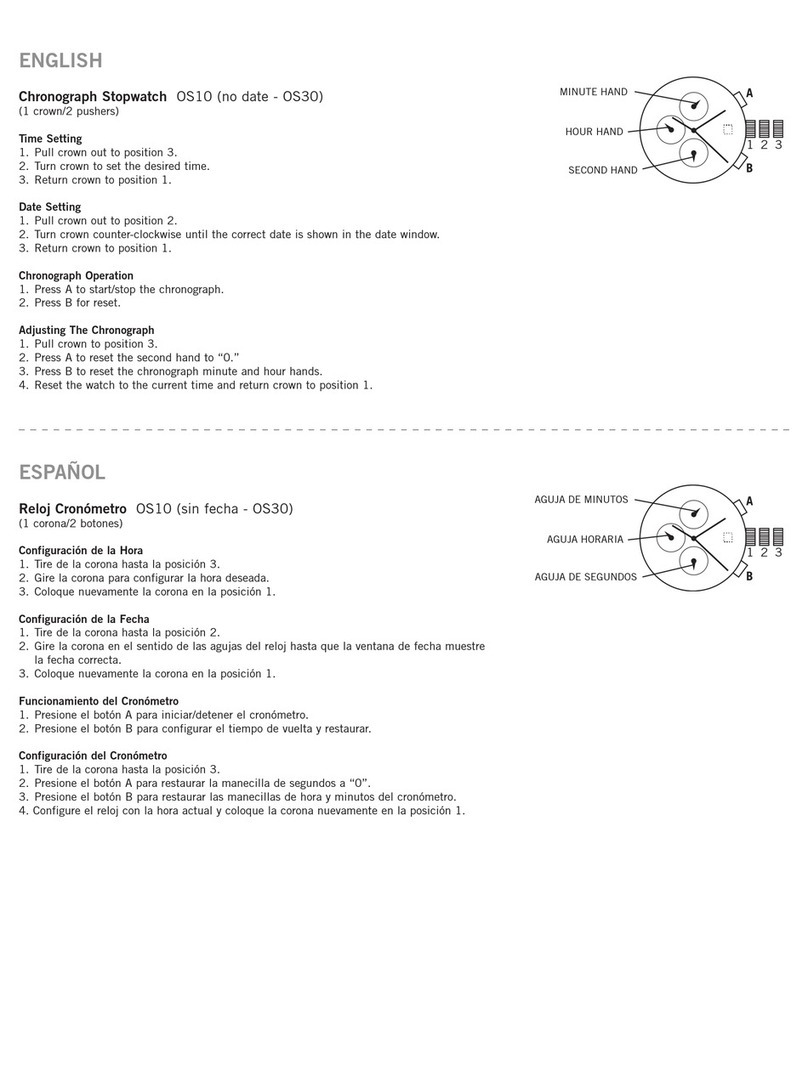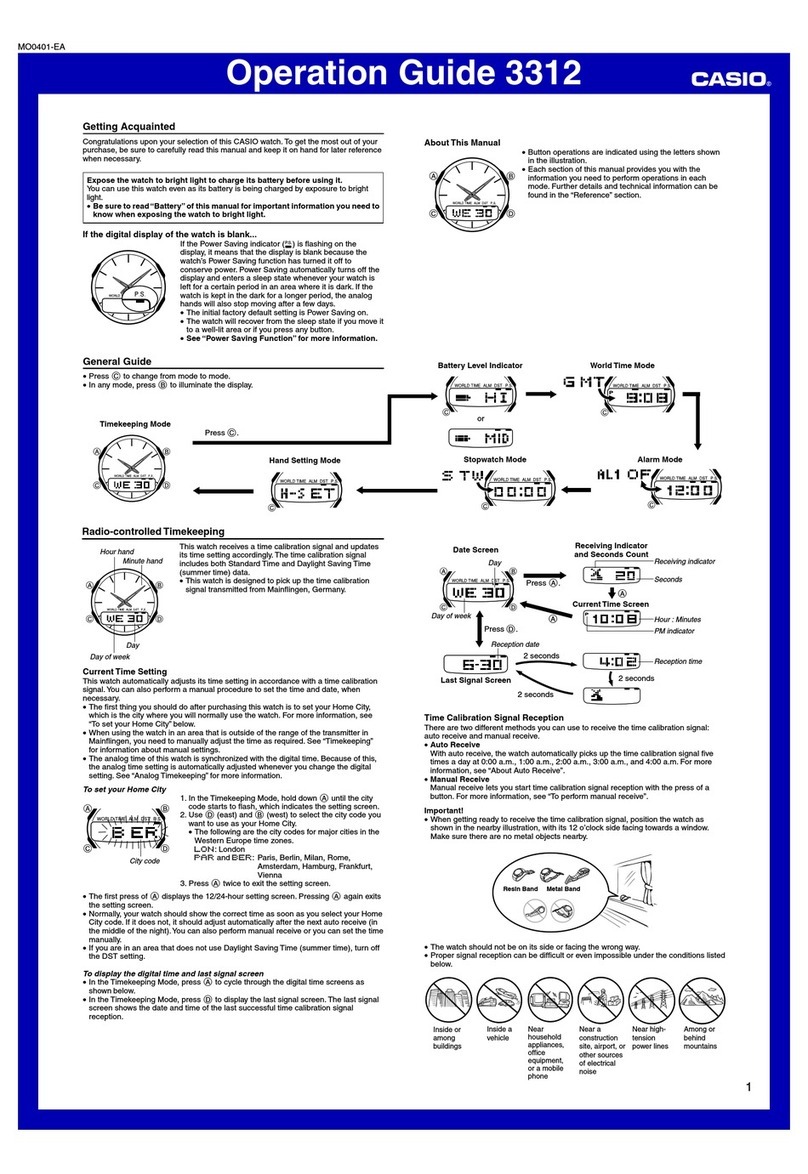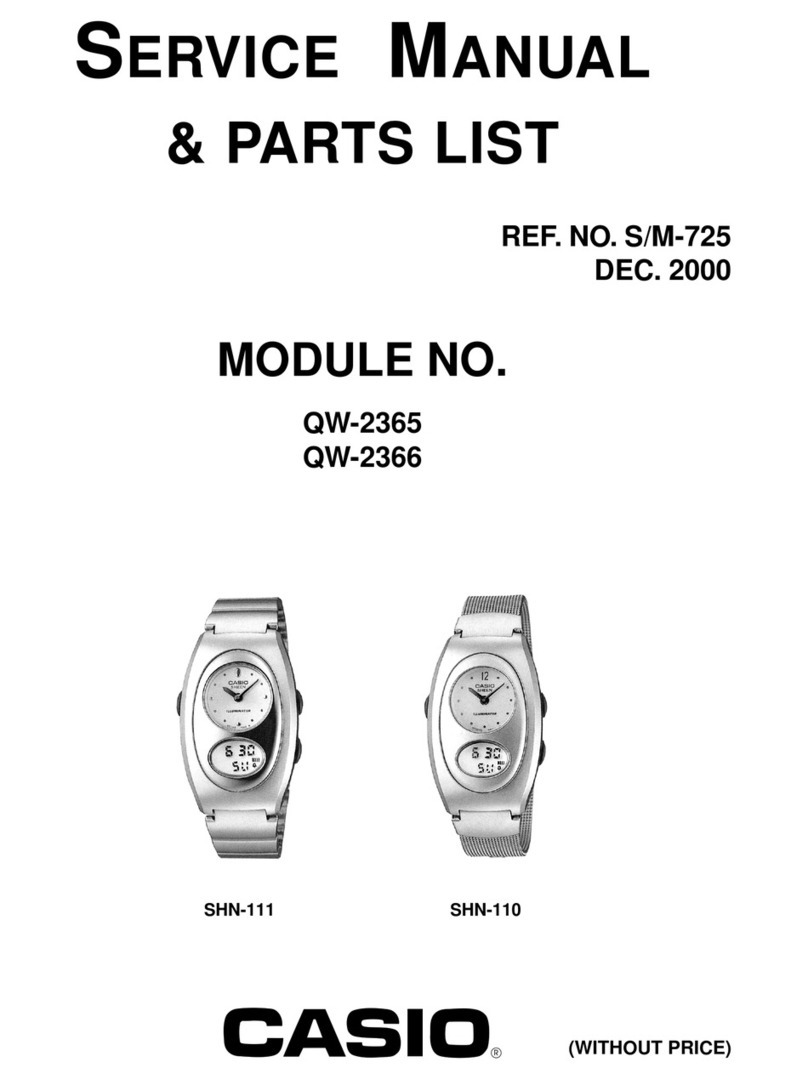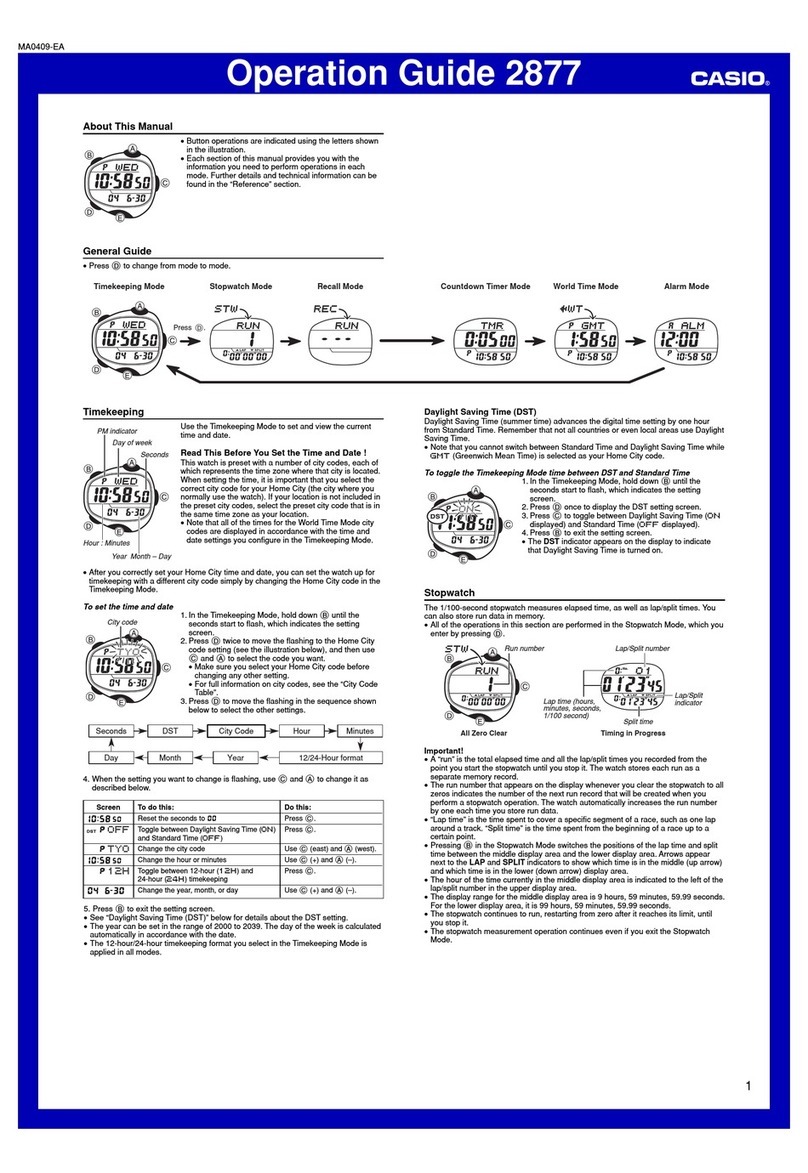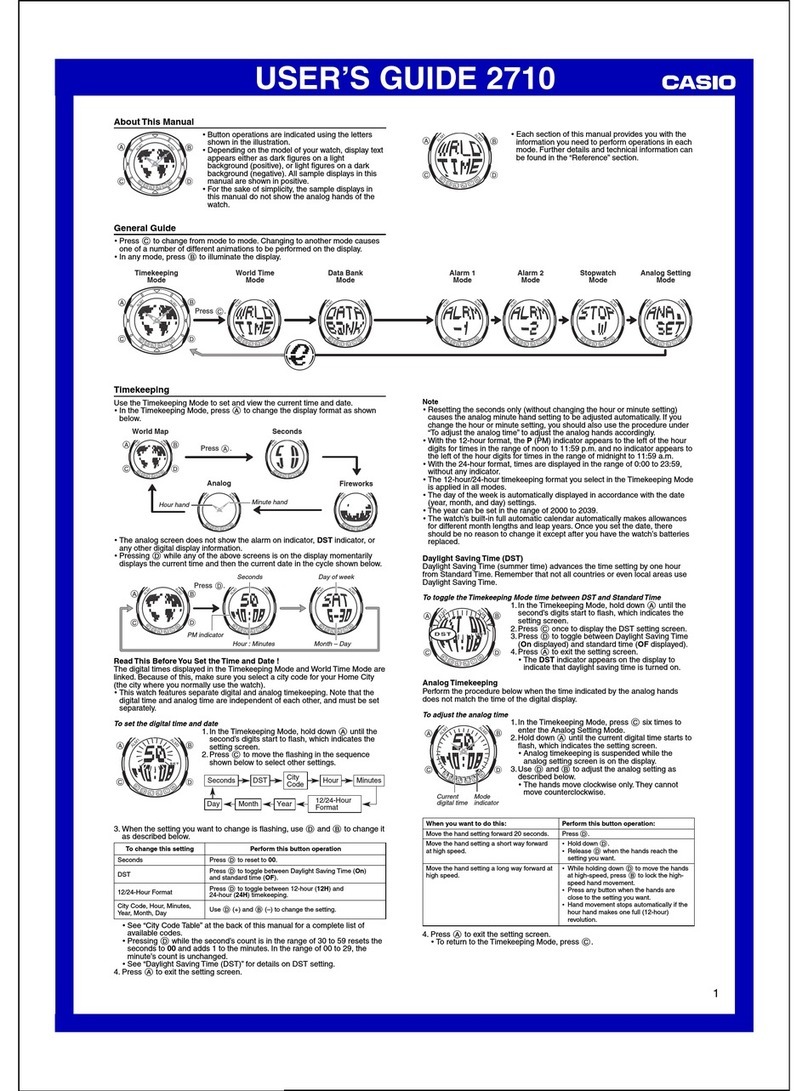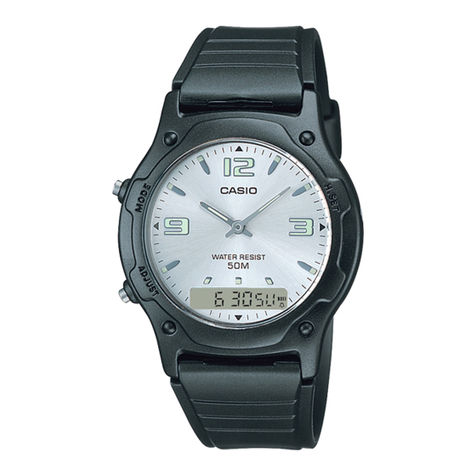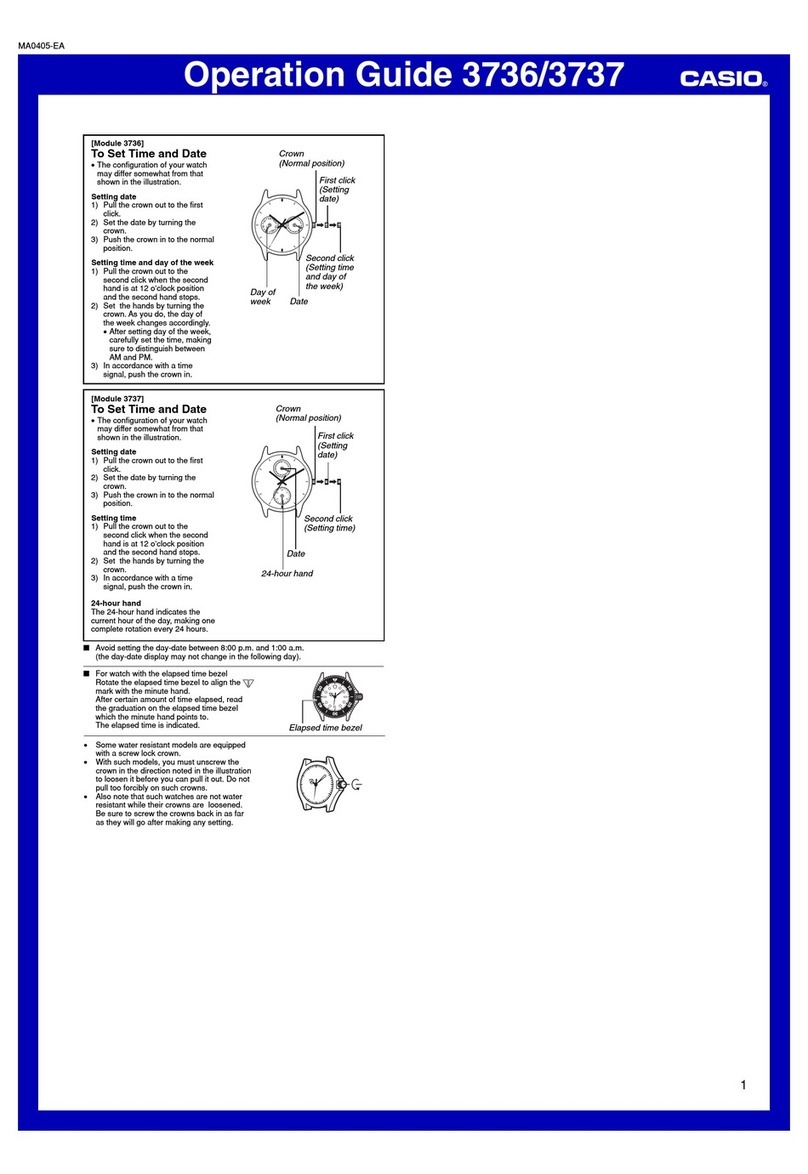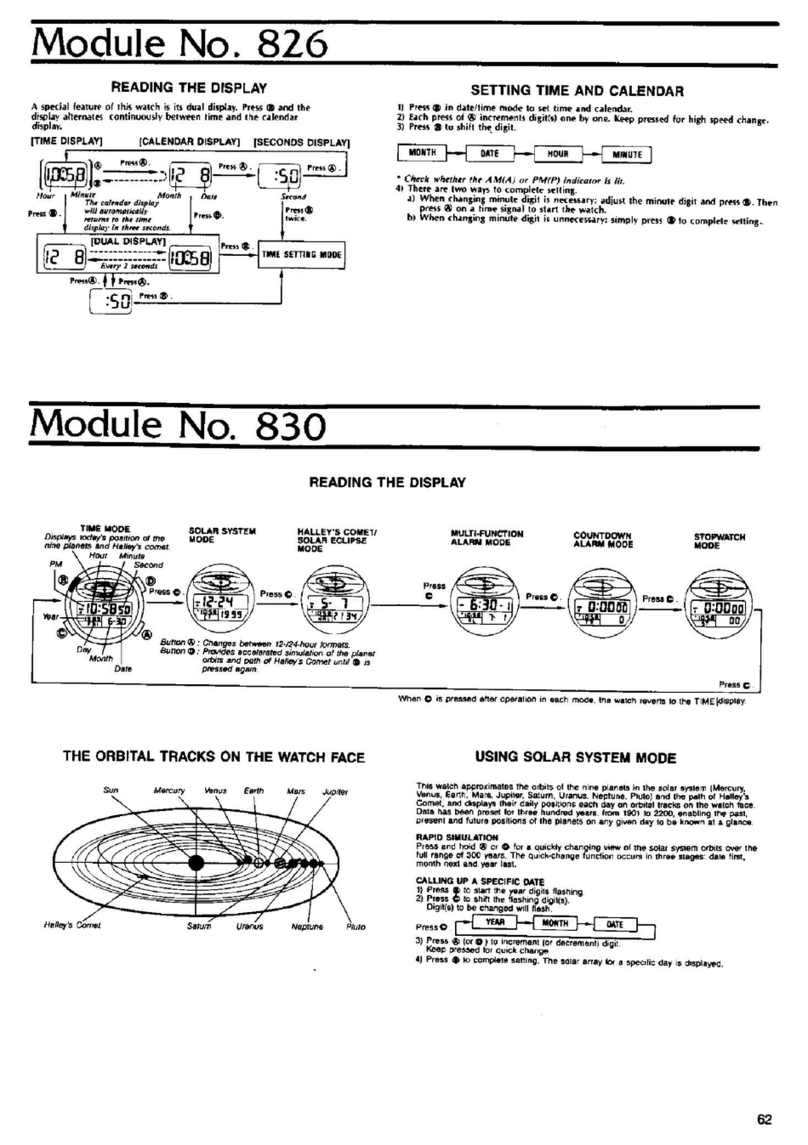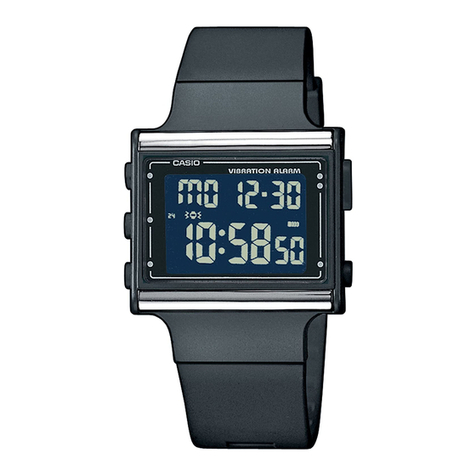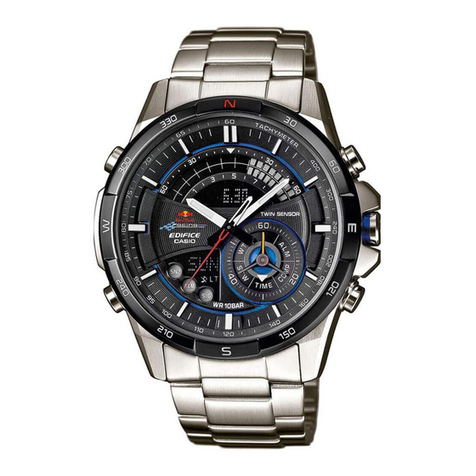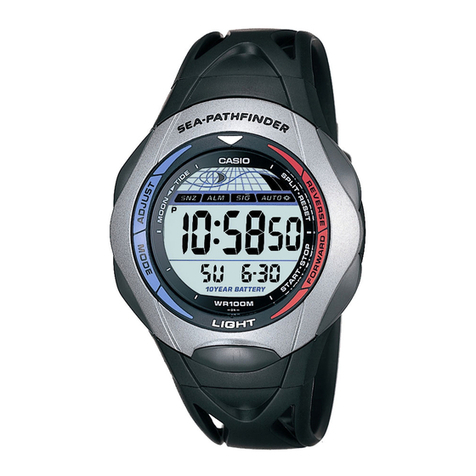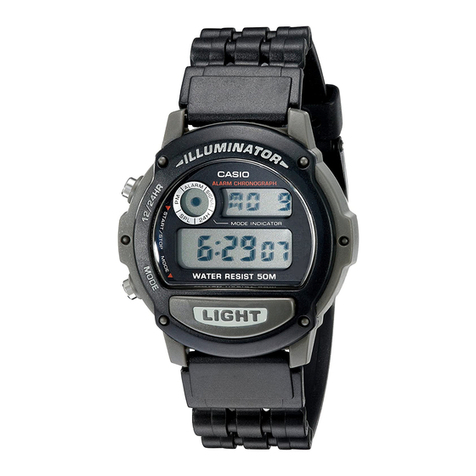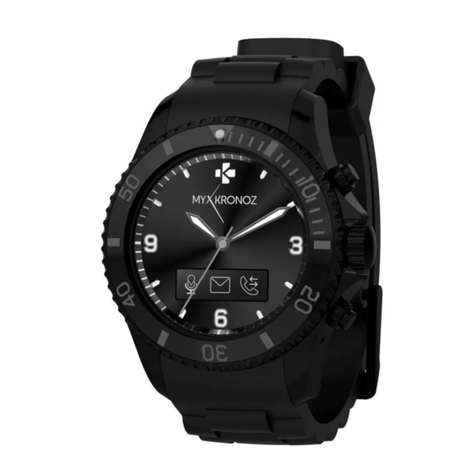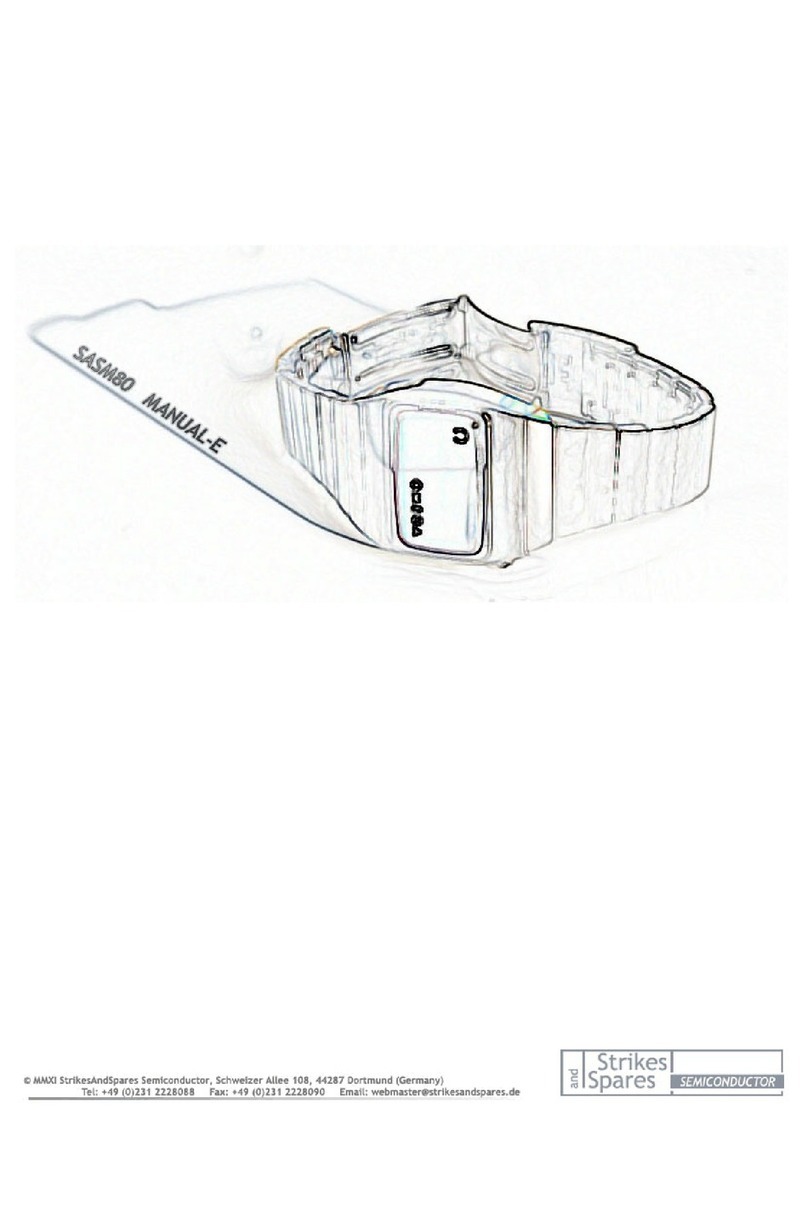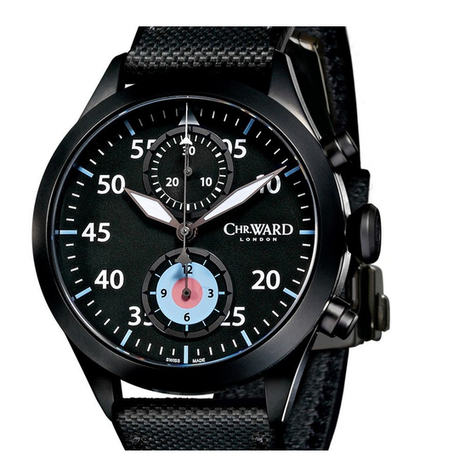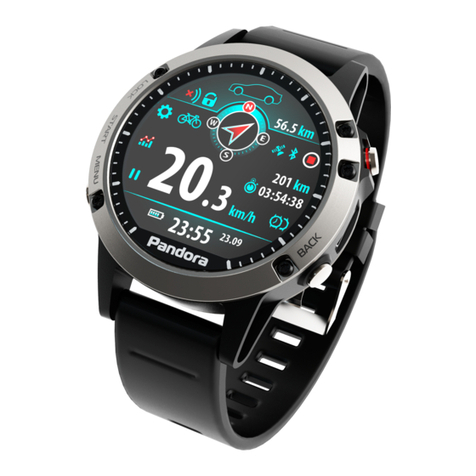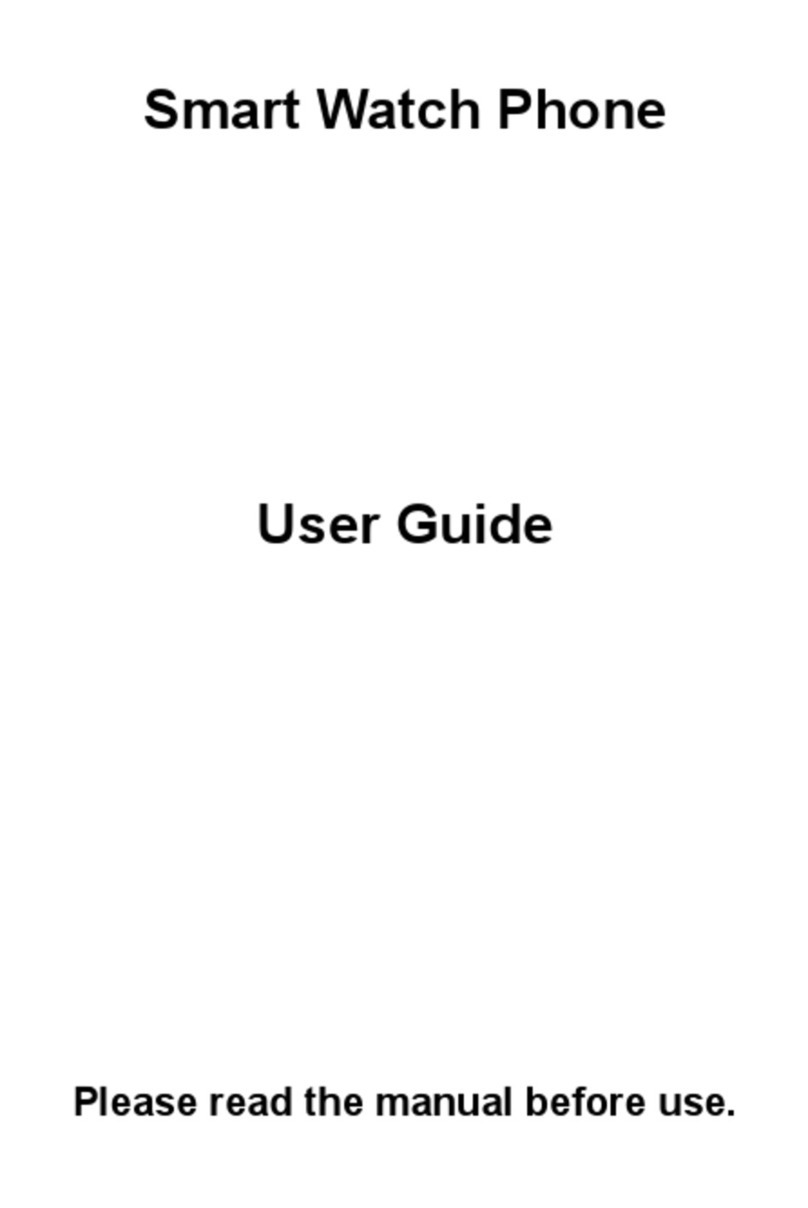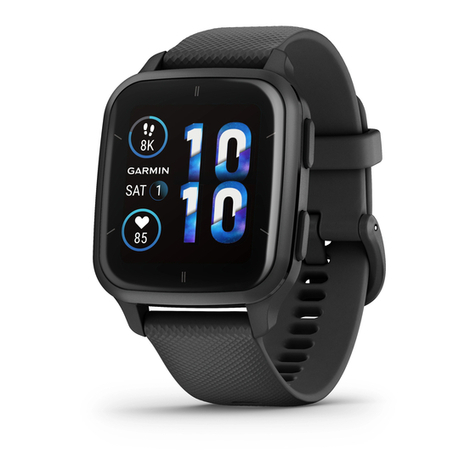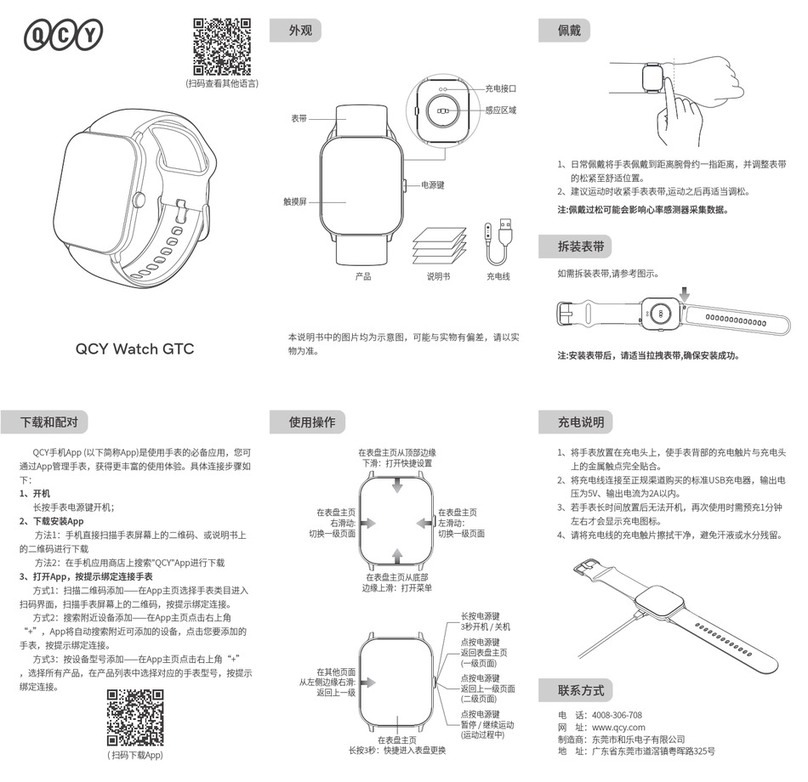
— 5 —
About Auto Receive
When auto receive is turned on, the watch automatically starts to receive the
time calibration signal when the digital time in the Timekeeping Mode reaches
2:00 AM, 4:00 AM and 6:00 AM each day (calibration times).
Note
•The auto receive operation is performed only if the watch is in the
Timekeeping or World Time Mode when one of the calibration times is
reached.
It is not performed if a calibration time is reached while you are making
settings (while settings are flashing on the display), while an alarm is
sounding, or while a silent alert operation is being performed.
•Auto receipt of the calibration signal is designed to be performed early in the
morning, while you sleep (provided that the digital time is set correctly).
Before going to bed for the night, remove the watch from your wrist, and put it
in a location where it can easily receive the signal.
•The receive indicator indicates that either the 2:00 AM, 4:00 AM, or 6:00 AM
calibration signal reception was successful.Note, however, that the receive
indicator is cleared from the display at 3:00 AM each day.
•If you do not see the receive indicator except for the above reason, it means
there was some problem with the calibration reception operation. Either
perform reception manually, or make sure the watch is set up properly to
receive the time calibration signal for the next automatic reception time.
•When auto receive is turned on, the watch receives the calibration signal for
two to six minutes each day when the digital time reaches 2:00 AM, 4:00 AM
and 6:00 AM. Do not operate any of the watch’s buttons within six minutes
prior to or following the calibration times. Doing so can interfere with correct
calibration.
•Remember that reception of the calibration signal depends on the time
shown on the digital display.The receive operation will be performed
whenever the digital display shows 2:00 AM, 4:00 AM and 6:00 AM,
regardless of whether or not the displayed time is actually the correct time.
•When two or three receptions are successful, the watch uses the data of the
last reception for calibration.When only one reception is successful, the
watch uses the data of the successful reception.
To turn auto receive on and off
1.In the Timekeeping Mode, press B.This causes
the current auto receive on/off setting (the receive
indicator) to flash, which indicates the setting
screen.
2.Press Dto toggle auto receive on (ON) and off
(OFF).
3.Press Bto exit the setting screen.
l
l
l
l
l
l
l
l
l
l
l
l
l
l
l
l
l
l
l
l
Setting the DigitalTime and Date Manually
Make sure you select your Home City code (the city code whose time and date
you are setting) before change the current time and date settings.World Time
Mode times are all displayed in accordance with the Timekeeping Mode
settings.Because of this, World Time Mode times will not be correct if you do
not select the proper Home City code before setting the time and date in the
Timekeeping Mode.
To set the current digital time and date manually
1.In the Timekeeping Mode, press B.This causes
the current auto receive on/off setting (the receive
indicator) to flash, which indicates the setting
screen.
2.Press Cto move the flashing in the sequence
shown below to select other settings.
3.When the setting you want to change is flashing, use Aand/or Dto
change it as described below.
Auto
Receive
Seconds
DST
Frequency 12/24-Hour
Format
City Code
Month Year Minutes Hour
Day
l
l
l
l
l
l
l
l
l
l
l
l
l
l
l
l
l
l
l
l
ScreenSetting
Auto Receive
Frequency
City code
DST
12/24-Hour format
Hour, Minutes
Seconds
Month, Day, Year
Button Operations
Press Dto toggle auto receive on and off.
When TYO (Tokyo) is selected as the city
code, press Dto toggle the calibration
signal reception frequency among Auto
(FREQ. AT), 40KHz (FREQ. 40) and 60KHz
(FREQ. 60). Note that frequency selection is
available for the TYO city code only.
Use D(+) and A(–) to change the setting.
Press Dto toggle between Daylight Saving
Time (ON) and standard time (OFF).
•Pressing Dperforms a different operation
when HKG, TYO, SEL, NYC, CHI, DEN,
LAX, ANC or HNL is selected as Home City
Code.See "Auto Summer Time (DST)
Switching".
Press Dto toggle between 12-hour (12H)
and 24-hour (24H) timekeeping.
Use D(+) and A(–) to change the
setting.
Press Dto reset the seconds to 00.
Use D(+) and A(–) to change the setting.
4.Press Bto exit the setting screen.
•The auto receive setting is used for time calibration signal reception only.See
“
About Auto Receive
”
for details.
•See
“
City Code Table
”
at the back of this manual for a complete list of
available city codes.
•Resetting the seconds to 00 while the current count is in the range of 30 to
59 causes the minutes to be increased by 1.In the range of 00 to 29, the
seconds are reset to 00 without changing the minutes.
AnalogTimekeeping
The analog time of this watch is synchronized with the digital time.The analog
time setting is adjusted automatically whenever you change the digital time.
Note
•The hands for the analog timepiece move to adjust to a new setting whenever
any of the following occurs.
When you change the digital time setting manually
When the digital time setting is changed by time calibration signal reception
When you change the Home City code and/or DST setting
•If the analog time does not match the digital time for any reason, use the
procedure described under
“
To adjust the analog time
”
to match the analog
setting to the digital setting.
•Whenever you need to adjust both the digital and the analog time settings
manually, make sure you adjust the digital setting first.
•Depending on how much the hands have to move in order to adjust to the
digital time, it may take some time before the analog hands stop moving.
To adjust the analog time
1.In the Timekeeping Mode, press Cfive times to
enter the Hand Setting Mode.
2.Press Band the current digital time starts to
flash, which indicates the setting screen.
3. Use D(+) and A(–) to adjust the analog setting
as described below.
Current time
When you want to do this:
Move the hand setting
forward 20 seconds
Move the hand setting
back 20 seconds
Move the hand setting a short
way forward at high speed
Movethe hand setting a
short way back at high speed
Move the hand setting a
long way forward at high
speed
l
l
l
l
l
l
l
l
l
l
l
l
l
l
l
l
l
Perform this button operation:
•Press D.
•Press A.
•Hold down D.
•Release Dwhen the hands reach the
setting you want.
•Hold down A.
•Release Awhen the hands reach the
setting you want.
•While holding down Dto move the hands
at high-speed, press Ato lock the high-
speed hand movement.
•Press any button when the hands are
close to the setting you want.
•Hand movement stops automatically if the
hour hand makes one full (12-hour)
revolution.
•While holding down Ato move the hands
at high-speed, press Dto lock the high-
speed hand movement.
•Press any button when the hands are
close to the setting you want.
•Hand movement stops automatically if the
hour hand makes one full (12-hour)
revolution.
Move the hand setting a
long way back at high
speed
4.Press Bto exit the setting screen.
•The minute hand will be adjusted slightly to match the seconds when you exit
the setting screen.
•To return to the Timekeeping Mode, press C.
To view the time in another city code
While in the World Time Mode, press Dto scroll through the city codes (time
zones) to the east or Ato scroll to the west.
•If the current time shown for a city is wrong, check yourTimekeeping Mode
time and Home City settings and make the necessary changes.
To toggle a city code time between standard time and Daylight SavingTime
1.In the World Time Mode, use Aand Dto display
the city code (time zone) whose standard time/
Daylight Saving Time setting you want to change.
2.Press Bto toggle Daylight Saving Time (DST
displayed) and standard time (DST not displayed).
•The DST indicator is on the display whenever you
display a city code for which Daylight Saving Time
is turned on.
•Note that the DST/Standard Time setting affects only the currently displayed
city code.Other city codes are not affected.
•Daylight Saving Time (DST) advances the time setting by one hour from
Standard Time. Remember that the not all countries or even local areas use
Daylight Saving Time.
•Note that you cannot use the World Time Mode to change the DST ON/OFF
setting of the Home City code you currently have selected in the Timekeeping
Mode.See information about turning the Home City code DST setting on and
off.
•The watch will perform a signal receive operation even if it is in the World
Time Mode when a calibration time is reached. If this happens, the World
Time Mode time settings will be adjusted in accordance with the Timekeeping
Mode’s Home City code time.
World Time
World Time shows the current time in 30 cities (29
time zones) around the world.
•For full information on city codes, see the
“
City
Code Table
”
at the back of this manual.
•The current time for all city codes in theWorld Time
Mode is calculated in accordance with the
Greenwich Mean Time (GMT) differential for each
city, based on the your Home City time setting.
•All of the operations in this section are performed in
the World Time Mode, which you enter by pressing
C.
Current time in the
selected city code
City code
GMT
differential
